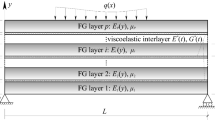Abstract
Dynamic modeling for incompressible hyperelastic materials with large deformation is an important issue in biomimetic applications. The previously proposed lower-order fully parameterized absolute nodal coordinate formulation (ANCF) beam element employs cubic interpolation in the longitudinal direction and linear interpolation in the transverse direction, whereas it cannot accurately describe the large bending deformation. On this account, a novel modeling method for studying the dynamic behavior of nonlinear materials is proposed in this paper. In this formulation, a higher-order beam element characterized by quadratic interpolation in the transverse directions is used in this investigation. Based on the Yeoh model and volumetric energy penalty function, the nonlinear elastic force matrices are derived within the ANCF framework. The feasibility and availability of the Yeoh model are verified through static experiment of nonlinear incompressible materials. Furthermore, dynamic simulation of a silicone cantilever beam under the gravity force is implemented to validate the superiority of the higher-order beam element. The simulation results obtained based on the Yeoh model by employing three different ANCF beam elements are compared with the result achieved from a commercial finite element package as the reference result. It is found that the results acquired utilizing a higher-order beam element are in good agreement with the reference results, while the results obtained using a lower-order beam element are different from the reference results. In addition, the stiffening problem caused by volumetric locking can be resolved effectively by applying a higher-order beam element. It is concluded that the proposed higher-order beam element formulation has satisfying accuracy in simulating dynamic motion process of the silicone beam.











Similar content being viewed by others
References
Fung, Y.C.: Biomechanics: Mechanical Properties of Living Tissues. Springer, New York (1993)
Shabana, A.A.: Definition of the slopes and the finite element absolute nodal coordinate formulation. Multibody Syst. Dyn. 1, 339–348 (1997)
Shabana, A.A.: Computational Continuum Mechanics, 1st edn. Cambridge University Press, Cambridge (2008)
Shabana, A.A., Schwertassek, R.: Equivalence of the floating frame of reference approach and finite element formulations. Int. J. Non-Linear Mech. 33, 417–432 (1998)
Nachbagauer, K.: State of the art of ANCF elements regarding geometric description, interpolation strategies, definition of elastic forces, validation and the locking phenomenon in comparison with proposed beam finite elements. Arch. Comput. Methods Eng. 21, 293–319 (2014)
Maqueda, L.G., Shabana, A.A.: Poisson modes and general nonlinear constitutive models in the large displacement analysis of beams. Multibody Syst. Dyn. 18, 375–396 (2007)
Maqueda, L.G., Mohamed, N.A., Shabana, A.A.: Use of general nonlinear material models in beam problems: application to belts and rubber chains. J. Comput. Nonlinear Dyn. 5, 021003 (2010)
Kerkkanen, K.S., Sopanen, J.T., Mikkola, A.M.: A linear beam finite element based on the absolute nodal coordinate formulation. J. Mech. Des. 127, 621–630 (2005)
Gerstmayr, J., Shabana, A.A.: Analysis of thin beams and cables using the absolute nodal coordinate formulation. Nonlinear Dyn. 45, 109–130 (2006)
Gerstmayr, J., Irschik, H.: On the correct representation of bending and axial deformation in the absolute nodal coordinate formulation with an elastic line approach. J. Sound Vib. 318, 461–487 (2008)
Gerstmayr, J., Sugiyama, H., Mikkola, A.: Review on the absolute nodal coordinate formulation for large deformation analysis of multibody systems. J. Comput. Nonlinear Dyn. 8, 031016 (2013)
Jung, S., Park, T., Chung, W.: Dynamic analysis of rubber-like material using absolute nodal coordinate formulation based on the non-linear constitutive law. Nonlinear Dyn. 63, 149–157 (2011)
Hussein, B.A., Sugiyama, H., Shabana, A.A.: Coupled deformation model in the large deformation finite-element analysis: problem definition. J. Comput. Nonlinear Dyn. 2, 146–154 (2007)
Shabana, A.A., Yakoub, R.Y.: Three dimensional absolute nodal coordinate formulation for beam elements: theory. J. Mech. Des. 123, 606–613 (2001)
Yakoub, R.Y., Shabana, A.A.: Three dimensional absolute nodal coordinate formulation for beam elements: implementation and applications. J. Mech. Des. 123, 614–621 (2001)
Schwab, A.L., Meijaard, J.P.: Comparison of three-dimensional flexible beam elements for dynamic analysis: classical finite element formulation and absolute nodal coordinate formulation. J. Comput. 5, 011010 (2010)
Shen, Z., Li, P., Liu, C., et al.: A finite element beam model including cross-section distortion in the absolute nodal coordinate formulation. Nonlinear Dyn. 77, 1019–1033 (2014)
Bonet, J., Wood, R.D.: Nonlinear Continuum Mechanics for Finite Element Analysis. Cambridge University Press, Cambridge (1997)
Yeoh, O.H.: Characterization of elastic properties of carbon black filled rubber vulcanizates. Rubber Chem. Technol. 66, 754–771 (1990)
Selvadurai, A.P.S.: Deflections of a rubber membrane. J. Mech. Phys. Solids 54, 1093–1119 (2006)
Bathe, K.J.: Finite Element Procedures. Prentice Hall, Upper Saddle River (1996)
Li, P., Gantoi, F.M., Shabana, A.A.: Higher order representation of the beam cross section deformation in large displacement finite element analysis. J. Sound Vib. 330, 6495–6508 (2011)
Orzechowski, G., Shabana, A.A.: Analysis of warping deformation modes using higher order ANCF beam element. J. Sound Vib. 363, 428–445 (2016)
Orzechowski, G., Fraczek, J.: Nearly incompressible nonlinear material models in the large deformation analysis of beams using ANCF. Nonlinear Dyn. 82, 451–464 (2015)
Acknowledgements
This research was supported by the National Natural Science Foundation of China (11772186 and 11272203).
Author information
Authors and Affiliations
Corresponding author
Rights and permissions
About this article
Cite this article
Xu, Q., Liu, J. An improved dynamic model for a silicone material beam with large deformation. Acta Mech. Sin. 34, 744–753 (2018). https://doi.org/10.1007/s10409-018-0759-y
Received:
Accepted:
Published:
Issue Date:
DOI: https://doi.org/10.1007/s10409-018-0759-y




